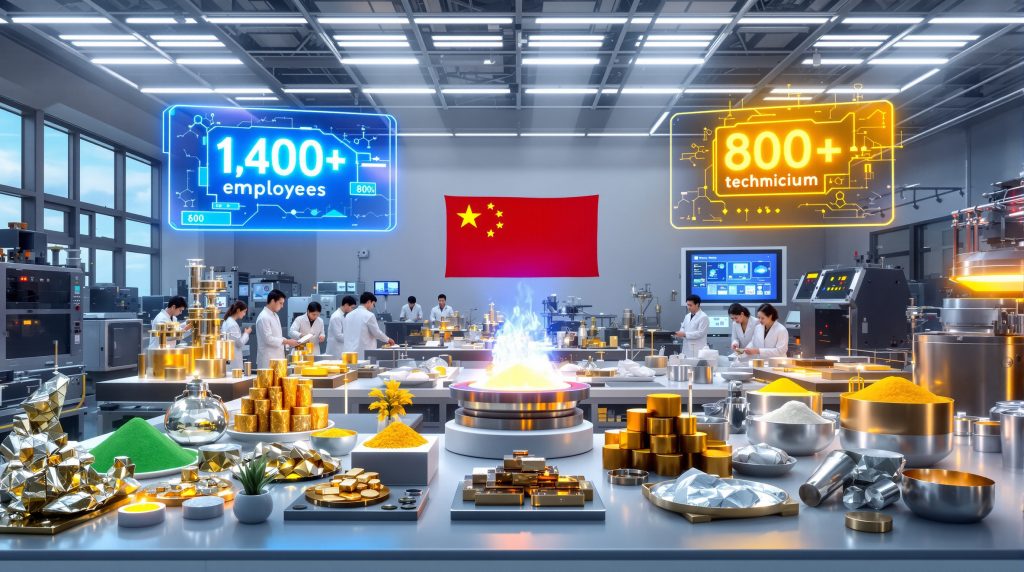Understanding China's Strategic Approach to Rare Earth Workforce Development
China's rare earth research institutions are implementing comprehensive human capital reforms designed to strengthen the nation's technological leadership in critical materials processing. These initiatives focus on building specialised expertise across the entire rare earth value chain, from extraction through advanced manufacturing applications. Furthermore, this approach to critical minerals energy transition demonstrates the strategic importance of workforce development in maintaining global competitiveness.
The Institute of Rare Earths under the Chinese Academy of Sciences has emerged as a prime example of this strategic transformation. In the first three quarters alone, the organisation achieved RMB 164 million in consolidated revenue whilst securing 54 patents and initiating 94 new research projects. This performance demonstrates how China's rare earth institute talent reforms are generating tangible results across multiple operational dimensions.
Key Performance Metrics from Recent Reforms:
- 42 new technical certification disciplines established
- 1,400+ employees participating in advanced training programmes
- 800+ technicians trained annually at new facilities
- 9 doctoral-level researchers recruited in recent quarters
The institutional approach reflects broader strategic objectives aligned with China's policy framework for technological advancement. These reforms position workforce development as inseparable from maintaining rare earth processing dominance, creating systematic pathways for technical expertise cultivation throughout the value chain.
What Makes China's Rare Earth Talent Pipeline Unique?
Dual-Engine Workforce Development Model
Chinese institutions have pioneered an integrated approach linking individual career advancement with industrial modernisation goals. This system creates structured pathways for technical professionals whilst simultaneously addressing critical skill gaps in rare earth processing. Additionally, this model incorporates lessons from mining industry evolution to create sustainable development programmes.
The dual-engine model operates through parallel recruitment mechanisms that serve complementary institutional needs. Recent data reveals 9 doctorates and masters recruited, including one doctorate from a C9 university (China's equivalent of Ivy League institutions). Additionally, 7 high-level talents were engaged through flexible arrangements, demonstrating the system's adaptability.
Career Progression Framework:
- Master Craftsman certification tracks
- Chief Technician advancement programmes
- National-level metallurgist qualifications
- Specialised materials technician credentials
This structure recognises that institutional innovation requires both cutting-edge research capability and mature technical operational expertise. The talent development strategy creates two distinct career pathways:
- Academic Excellence Track: Targeting individuals with advanced research credentials from elite institutions
- Practical Expertise Track: Engaging experienced technical professionals through flexible arrangements
Recent achievements include 10 people entering doctoral programmes, 5 earning doctorates, and 3 individuals selected into the Ministry of Industry & Information Technology Manufacturing Talent Support Plan. These metrics demonstrate institutional coordination between organisational talent development and state-level talent recognition systems.
Focus on Midstream Processing Expertise
The reform strategy prioritises developing skilled operators for complex refining and separation processes. These technical roles require deep understanding of chemical separation methodologies, metallurgical processing techniques, quality control protocols, and environmental compliance standards. However, this emphasis also reflects insights from rare earth reserves analysis regarding the strategic importance of processing capabilities.
Strategic emphasis on midstream processing expertise reflects recognition that rare earth value concentration occurs in the refining and separation stage of the supply chain. Whilst ore extraction requires resource access, processing competency determines product purity, energy efficiency, environmental compliance capability, and production scaling potential.
Recent operational achievements illustrate this focus:
- Completion of thousand-ton-scale rare-earth ore acid-alkali slurry decomposition demonstration line
- 6 kA and 10 kA electrolytic cells achieving stable industrial operation
- 16 tons of rare-earth aluminum insulated conductor production with 5% performance improvements
- 5 tons of steel-core rare-earth aluminum stranded conductor successfully deployed in grid infrastructure
The specialised knowledge required for efficient rare earth processing operations takes years to develop and cannot be easily replicated by international competitors seeking to establish alternative capabilities.
Which Technical Areas Are Receiving Priority Investment?
Core Competency Development Zones
| Technical Domain | Training Focus | Current Achievements | Development Timeline |
|---|---|---|---|
| Electrolytic Cell Operations | 6 kA, 10 kA systems | Stable industrial operation | 30 kA, 50 kA programmes in development |
| Ore Decomposition | Thousand-ton scale processing | Demonstration line completed | Continuous operation optimisation |
| Conductor Manufacturing | Rare-earth aluminum alloys | 5% performance improvements | Grid deployment achieved |
| Advanced Materials | Heat management textiles | Hundred-ton scale targeted | Full output demonstration planned |
The prioritisation sequence reveals institutional investment logic focused on mastering electrolytic cell technology at multiple capacity scales. Electrolytic cells function as the separation mechanism for rare earth elements, with higher capacity systems enabling larger batch processing and improved energy efficiency per unit output. In addition, this approach mirrors trends in AI in mining operations where technological advancement drives efficiency gains.
Research Project Distribution:
- 94 total new research projects initiated in reporting period
- 9 national-level projects representing strategic priorities
- 35 autonomous-region level projects addressing regional development needs
- 55 industry standards issued indicating process standardisation advancement
Advanced Manufacturing Capabilities
Research institutions are developing expertise in next-generation applications that extend beyond traditional rare earth processing into high-value manufacturing segments.
Production Achievements in Advanced Applications:
- Annual 50,000-unit micro-disc rare-earth permanent-magnet motors demonstration line development
- Hundred-ton scale rare-earth heat-management textiles production capabilities
- Enhanced electrical conductivity materials with demonstrated 5% performance improvements
- Industrial automation systems integration with processing equipment
These advanced manufacturing capabilities represent institutional evolution from raw material processing toward high-value downstream applications. The specific focus on heat-management textiles, permanent-magnet motors, and enhanced electrical conductivity conductors reflects strategic positioning in application domains with significant growth potential and technological complexity.
Case Study: Bayun-E'bo Green Power Integration Project
The Institute successfully deployed rare-earth aluminum conductors in operational grid infrastructure, producing and implementing 16 tons of rare-earth aluminum insulated conductor and 5 tons of steel-core rare-earth aluminum stranded conductor. This deployment achieved 5% improvement in electrical conductivity and mechanical performance, validating technology progression from laboratory development to commercial-scale deployment in critical infrastructure.
How Do These Reforms Impact Global Rare Earth Markets?
Supply Chain Implications
China's talent development initiatives strengthen its position across multiple market segments through enhanced production capabilities and technological innovation acceleration. Furthermore, this demonstrates how China's rare earth monopoly continues to evolve through strategic workforce investments.
Production Capacity Enhancements:
- Thousand-ton scale demonstration facilities operational
- Improved processing efficiency through advanced electrolytic cell technology
- Reduced environmental impact through integrated resource utilisation
- Enhanced product quality standards supporting export competitiveness
The systematic approach to talent development creates significant barriers for international competitors seeking to establish alternative rare earth processing capabilities. Developing technical specialists in midstream processing protects China's competitive advantage in the value chain segment where proprietary knowledge creates the highest barriers to international replication.
Technological Innovation Acceleration
Recent achievements demonstrate the effectiveness of China's rare earth institute talent reforms in generating measurable innovation outcomes:
- 54 patents secured including 6 international patents and 41 invention patents
- 43 academic papers published with 20 appearing in SCI journals
- 8 provincial/industry technology awards captured during reporting period
- RMB 107 million in research funding received year-to-date
This intellectual property generation supports China's strategic objective of maintaining technological leadership whilst creating additional revenue streams through technology licensing and conversion.
What Role Does International Collaboration Play?
Global Knowledge Exchange Programmes
Chinese institutions maintain strategic partnerships through international science and technology cooperation bases, joint research initiatives with foreign universities, technology transfer agreements, and academic exchange programmes. The Institute operates the Rare-Earth International Science & Technology Cooperation Base, which has completed acceptance procedures for next-stage development.
Export Control and Regulatory Expertise
Talent reforms include developing specialised capabilities in trade policy implementation, export licensing procedures, international compliance standards, and diplomatic engagement protocols. This expertise becomes increasingly important as rare earth materials face enhanced scrutiny in global trade relationships.
Recent regulatory developments require institutions to maintain sophisticated understanding of:
- International trade law compliance
- Technology transfer restrictions
- Export control classification systems
- Diplomatic engagement protocols for scientific cooperation
How Are Digital Technologies Enhancing Training Programmes?
Simulation-Based Learning Systems
Modern training facilities incorporate advanced process simulation software, virtual reality training environments, digital twin modelling systems, and real-time performance monitoring to accelerate skill development and reduce training risks. Consequently, this approach aligns with broader trends in data-driven mining operations that emphasise technological integration.
Data-Driven Skill Assessment
Certification Methodology:
- Independent examination protocols ensuring standardised competency measurement
- Performance tracking systems monitoring individual progress
- Continuous improvement feedback loops optimising training effectiveness
- Standardised competency measurements aligned with industry requirements
The integration of digital technologies enables more efficient talent development whilst maintaining rigorous standards for technical competency certification.
What Are the Long-Term Strategic Objectives?
Industrial Self-Reliance Goals
China's rare earth institute talent reforms support broader objectives including reduced dependence on foreign expertise, enhanced technological sovereignty, improved export competitiveness, and strengthened supply chain resilience. Moreover, these initiatives demonstrate strategic planning capabilities that extend beyond immediate operational needs.
Future-Focused Initiatives:
- Next-generation processing technologies development
- Environmental sustainability improvements through cleaner production methods
- Product quality enhancements supporting premium market positioning
- Cost reduction strategies maintaining competitive advantage
Market Leadership Sustainability
The Institute has positioned itself to accelerate commercialisation through employee technology-results assignment reform, selecting mixed rare-earth ore acid-alkali slurry decomposition process technology as the pilot area. This initiative generated conversion revenue representing 30% of incremental net profit from technology during the reporting period.
Strategic Implementation Timeline:
- Q4 targets: 3-5 key technology conversions into commercial pipeline
- Revenue growth: Targeting expansion of external business share
- R&D acceleration: RMB 30 million additional funding targeted for Q4
- Production scaling: Full output achievement for demonstration lines
How Do These Changes Affect Global Competition?
Competitive Advantage Reinforcement
China's systematic approach to rare earth institute talent reforms creates significant barriers for international competitors seeking to establish alternative rare earth processing capabilities. The specialised knowledge required for efficient operations takes years to develop and cannot be easily replicated. In addition, insights from critical mineral supply chain analysis confirm the strategic importance of processing expertise in maintaining competitive advantages.
The commitment to conductor development and advanced manufacturing demonstrates strategic positioning beyond basic processing toward advanced materials manufacturing, creating additional competitive moats through technological complexity and higher profit margins.
Market Dynamics Implications
Strategic Considerations for Global Markets:
- Increased Chinese technological capabilities across the value chain
- Enhanced processing efficiency standards setting global benchmarks
- Potential supply chain dependencies for advanced applications
- Innovation acceleration in downstream applications creating new market segments
The Institute's achievement of RMB 35.66 million in external revenue, exceeding full-year budget targets by 18%, demonstrates commercial viability of the talent-focused reform strategy whilst generating resources for continued expansion.
Investment and Market Psychology Considerations
Market Positioning Strategy
The rare earth institute talent reforms reflect sophisticated understanding of market psychology and competitive positioning. By simultaneously developing basic processing capabilities and advanced manufacturing applications, Chinese institutions create multiple value capture points throughout the supply chain.
Revenue Diversification Achieved:
- RMB 164 million consolidated revenue demonstrating operational scale
- RMB 3.54 million total profit achievement meeting annual targets
- Technology licensing revenue contributing 30% of incremental profit
- External revenue exceeding budget by 18% indicating market demand strength
Investment Strategy Implications
For investors analysing rare earth markets, China's talent development strategy indicates long-term commitment to maintaining technological leadership whilst expanding commercial applications. The systematic approach suggests sustained competitive advantages that may prove difficult for alternative suppliers to replicate quickly.
Key Investment Considerations:
- Technology barriers increasing for international competitors
- Commercial viability demonstrated through revenue achievement
- Innovation pipeline supported by substantial R&D funding
- Market expansion into higher-value applications segments
Disclaimer: The financial and operational data presented reflects publicly reported information from Chinese state-sector sources. Market predictions and competitive analysis represent informed speculation based on available data and should not be considered definitive investment advice. Readers should conduct independent verification and consult qualified professionals before making investment decisions based on this analysis.
Ready to Capitalise on Critical Minerals Market Opportunities?
Discovery Alert's proprietary Discovery IQ model delivers real-time alerts on significant ASX mineral discoveries, instantly empowering subscribers to identify actionable opportunities ahead of the broader market in critical minerals and rare earth sectors. Begin your 30-day free trial today at Discovery Alert and secure your market-leading advantage in this rapidly evolving landscape.




